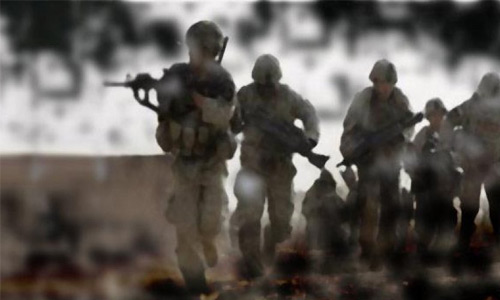The history of war and peace goes beyond millenniums. Where war and destruction convey a nasty face value, it is also a multi-billion dollar venture for companies engaged in warfare production. These politically connected and financially sustained firms have a huge chunk of political lobbyists in a rapidly growing payroll. In retrospect, the idea of igniting unrest and promoting sectarianism at a given geography is first decided in fancy office buildings in renowned metropolitan cities, involving these firms and paid politicians as partnered stakeholders. The very essence of the business revolves around political turmoil and hostile relations as key determinants for lucrative arms deal.
As we all know, the epicenter of waging wars is acquisition of money. In contemporary terms, it is a brutal rampage aimed at looting a pinpointed geography’s natural resources, auspices over precious resident commodities, and worst than all, using the geography as buffer zones for illicit drug trafficking and its mass plantations. The process simultaneously pollutes local cultures with vulgar, unorthodox socio-cultural imports, which are largely at odds with indigenous values.
The war industry operates around a number of classified and publically addressed interests. Hegemonic superiority, protecting an old ally against an adversary, and primarily the monetary incentive that it pumps back to the economy, opens up a multi dimensional faucet for a dynamic engagement in this constantly growing industry.
The Ivy League players, that reap the greatest chunk of financial profits from growing unrest and military fistfights around the world are state, and privately owned arms industries, tirelessly competing to provide sophisticated modern weaponry to recipient states. In fact, they are acting as insurance firms, convincing vulnerable states to buy weapons, in order to deter any attempts on sovereignty and national interests. Similar to any other typical business transaction, there is a clear-cut distinction in pre-planned deliverables among the stakeholders, brokers and ultimately the decision makers, perhaps wars can shift geographies, but sustained profitability demands endless wars.
This multi-billion dollar industry is in turn, generating an unprecedented opportunity for individuals and firms to pile up on personal wealth and political power. The producing states are vigorously running giant media outlets, as nonstop propaganda machines, advocating artificially generated risk reduction portfolio for countries in hostile status. Their analysis presents exaggerated and hypothesized bubbles of security threat to a targeted client, aiming to impress, and eventually lure the host in an arms deal with the selling stakeholder. It is an evident fact that the lucrative business of war is equivalently competitive and understandably relevant as any other licit industrial good in today’s infamous warring marketplace.
The business comprises of a large scale political reach, with considerable payouts to political practitioners. The National Rifle Association (NRA) in the U.S. is a very contemporary example for that matter. It pays out millions to political elites within and outside the executive branch, to safeguard their interests, and keep the status quo on gun laws, aligned within business interests. Associations as such, are discreetly involved in multi-lateral dimensions, bankrolling kleptocratic leaders globally, and state politicians locally, with sole discretion over the war industry.
It is a highly crowded market, involving supreme powers as perpetual sellers. These adversaries are in constant pursuit to acquire multi-billion dollar contracts in supplying modern warfare to needy recipients. Emerging powers such as India, Iran, Saudi Arabia, Turkey and Brazil are some of the potential buyers. These countries are allocating a remarkable chunk of their annual GDPs notching up military capabilities. By default this trending global intensity in military interventions, generates an intensifying supply for an equally growing demand, resulting in volume production of sophisticated weaponry.
Let us not forget that regional rivalries play a big part in stimulation of business for these companies too. For instance, the standoff in Yemen presented President Trump a potential opportunity to ink a USD 100 billion arms deal with its Saudi counterpart in the White House. The deal includes provision of tactical and advanced military reconnaissance equipments, elevating Kingdom’s military capabilities in order to withstand any direct military encounter with regional rival, Iran. Conversely, Russia is the chief arms supplier to Iran since the fall of Shah in 1979, Russian made tanks, air to air missiles and MiG-29s are presently active in the Iranian military vessels.
These rivals are constantly on the lookout for acquiring sophisticated modern warfare from their respective strategic alliances. Saudi Arabia under King Salman is unleashing unprecedented rhetoric over Iran’s contra affair in the Middle East. The Kingdom and its regional nemesis Iran are mounting closer to a full-scale military faceoff in the Middle East. The Saudi led military coalition in Yemen, is a direct warning to Iran’s allegedly growing meddling in majority inhabitant Arab states. . Iran, on the other hand, concerned about its growing isolation, is adhering to a tit for tat policy in taking on its regional rivals, Israel and Saudi Arabia. Iran understands its intrinsic geostrategic jewel to adversaries that of the United States, China and Russia.
Last but not least, the induction of privately owned security firms in today’s unconventional wars, is adding a newer set of prolonged catastrophic wars around the world. These firms are pocketing substantial profit by willing to operate in highly dangerous warzones as government and privates contractors. The operation involves hiring mercenaries, from poor countries and shipping them out to hostile regions in return for quick cash. Unfortunately, their combat operations fall under no written jurisdiction, allowing these militias in uniform, to commit war crimes with absolute immunity from any possible legal repercussions.
Home » Opinion » The Lucrative Business of War The Seller, The Buyer, The Victim
The Lucrative Business of War The Seller, The Buyer, The Victim
| Naser Koshan

